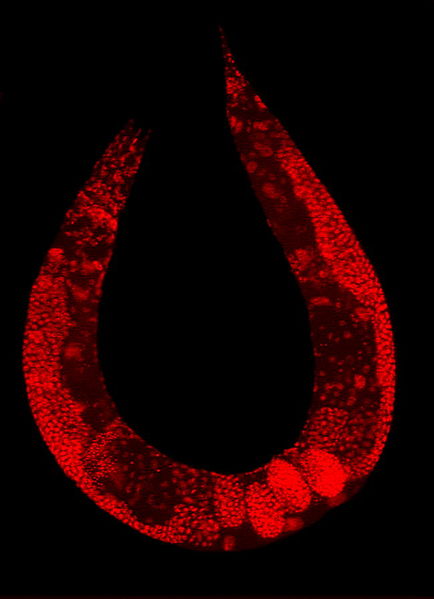Difference between revisions of "Category:Nematodes"
Jump to navigation
Jump to search
| (16 intermediate revisions by 2 users not shown) | |||
| Line 1: | Line 1: | ||
| − | {{ | + | {{frontpage |
| − | + | |pagetitle =Nematodes | |
| − | == | + | |pagebody = <div style="text-align: left; direction: ltr; margin-left: 1em;"> |
| − | + | Nematodes are one of the most prolific life-forms on this planet. Most are free-living, with species adapted to every imaginable habitat. Some are parasitic on plants, and others on animals. The animal parasitic nematodes form a large and diverse array of organisms. Occlusion of [[Pancreas - Parasitic Pathology|pancreatic ducts]] sometimes happens. | |
| − | |||
| − | Nematodes are one of the most prolific life-forms on this planet. Most are free-living, with species adapted to every imaginable habitat. Some are parasitic on plants, and others on animals. The animal parasitic nematodes form a large and diverse array of organisms. | ||
| − | |||
| − | |||
| − | |||
| − | |||
| − | |||
| − | |||
| − | |||
| − | |||
| − | |||
| − | |||
| − | |||
| − | |||
| − | |||
| − | |||
| − | |||
| − | |||
| − | |||
| − | |||
| − | |||
| − | |||
| − | |||
| − | |||
| − | |||
| − | |||
| − | |||
| − | |||
| − | |||
| − | |||
| − | |||
| − | |||
| − | |||
| − | |||
| − | |||
| − | |||
| − | |||
| − | |||
| − | |||
| − | |||
| − | |||
From the veterinary view-point, the nematodes are most conveniently grouped into '''superfamilies''' because their members often have similar life-cycles and epidemiological features. Superfamily names end in -oidea (the anglicised form is -oid, as in trichostrongyloid). | From the veterinary view-point, the nematodes are most conveniently grouped into '''superfamilies''' because their members often have similar life-cycles and epidemiological features. Superfamily names end in -oidea (the anglicised form is -oid, as in trichostrongyloid). | ||
| − | + | </div> | |
| − | = | + | |contenttitle =Content |
| − | + | |contentbody =<big><b> | |
| − | + | <br> | |
| − | + | <categorytree mode="pages">Nematodes</categorytree> | |
| − | |||
| − | |||
| − | |||
| − | |||
| − | |||
| − | |||
| − | |||
| − | |||
| − | |||
| − | |||
| − | |||
| − | |||
| − | |||
| − | |||
| − | |||
| − | |||
| − | + | Nematodes of Different Species | |
| + | :[[:Category:Cattle Nematodes|Cattle Nematodes]] | ||
| + | :[[:Category:Sheep Nematodes|Sheep Nematodes]] | ||
| + | :[[:Category:Goat Nematodes|Goat Nematodes]] | ||
| + | :[[:Category:Horse Nematodes|Horse Nematodes]] | ||
| + | :[[:Category:Pig Nematodes|Pig Nematodes]] | ||
| + | :[[:Category:Avian Nematodes|Avian Nematodes]] | ||
| + | :[[:Category:Dog Nematodes|Dog Nematodes]] | ||
| + | :[[:Category:Cat Nematodes|Cat Nematodes]] | ||
| + | :[[Rabbit Nematodes]] | ||
| + | :[[:Category:Rodent Nematodes|Rodent Nematodes]] | ||
| + | :[[Endoparasites - Donkey|Donkey Endoparasites]] | ||
| + | </b></big> | ||
| + | |logo = Nematode logo.jpg | ||
| + | }} | ||
| − | [[Category:Helminths]] | + | [[Category:Helminths]] [[Category:To_Do_-_Parasites]] |
Latest revision as of 17:13, 24 January 2011
Nematodes
Nematodes are one of the most prolific life-forms on this planet. Most are free-living, with species adapted to every imaginable habitat. Some are parasitic on plants, and others on animals. The animal parasitic nematodes form a large and diverse array of organisms. Occlusion of pancreatic ducts sometimes happens. From the veterinary view-point, the nematodes are most conveniently grouped into superfamilies because their members often have similar life-cycles and epidemiological features. Superfamily names end in -oidea (the anglicised form is -oid, as in trichostrongyloid).
Content
Nematodes of Different Species
- Cattle Nematodes
- Sheep Nematodes
- Goat Nematodes
- Horse Nematodes
- Pig Nematodes
- Avian Nematodes
- Dog Nematodes
- Cat Nematodes
- Rabbit Nematodes
- Rodent Nematodes
- Donkey Endoparasites
Subcategories
This category has the following 2 subcategories, out of 2 total.
Pages in category "Nematodes"
The following 4 pages are in this category, out of 4 total.
